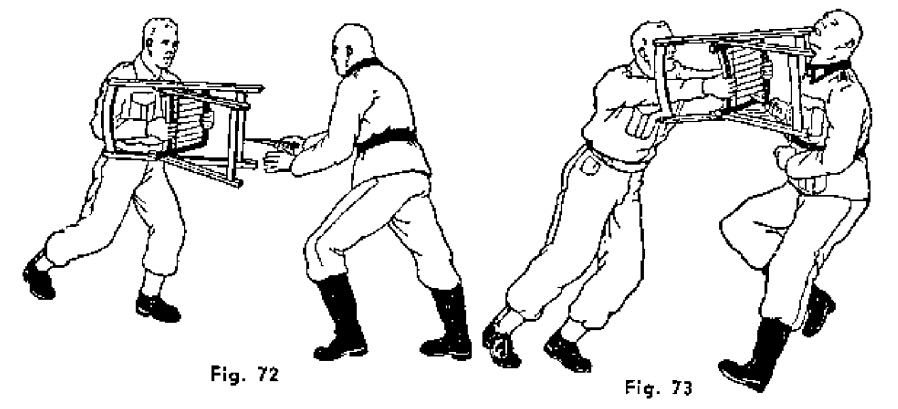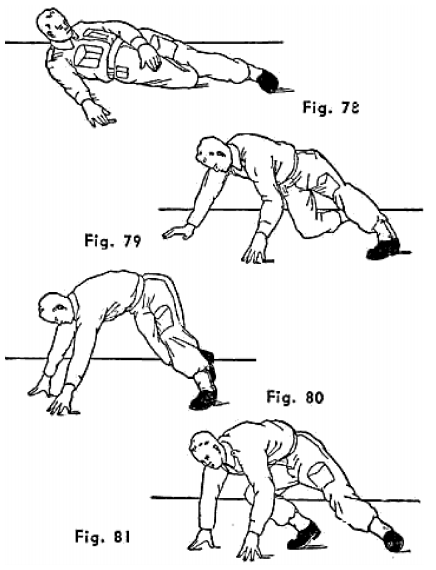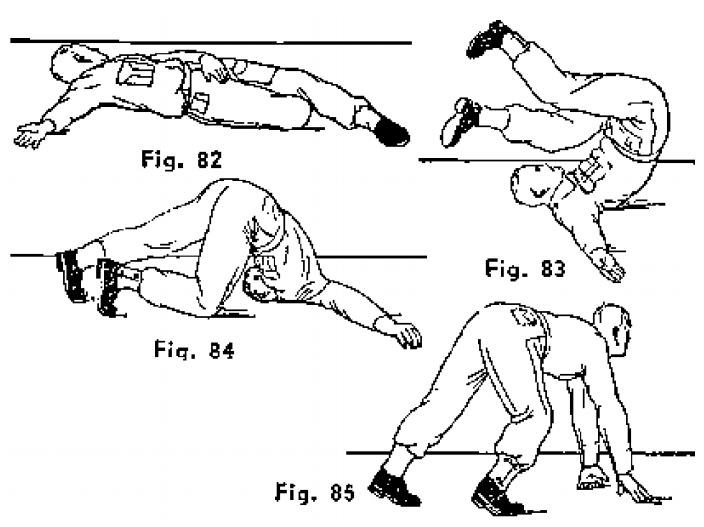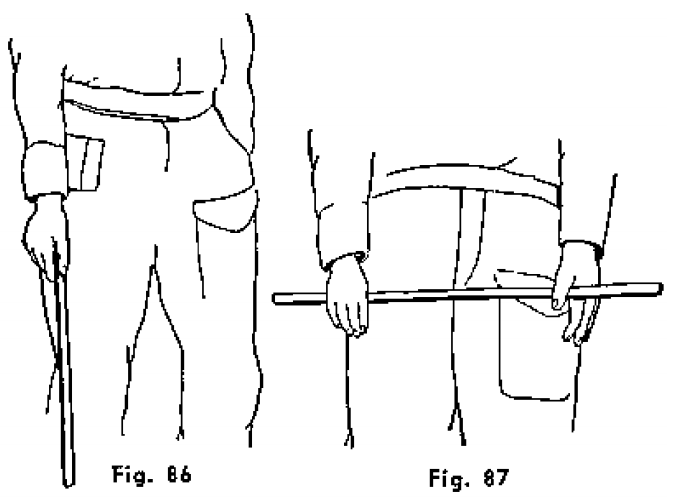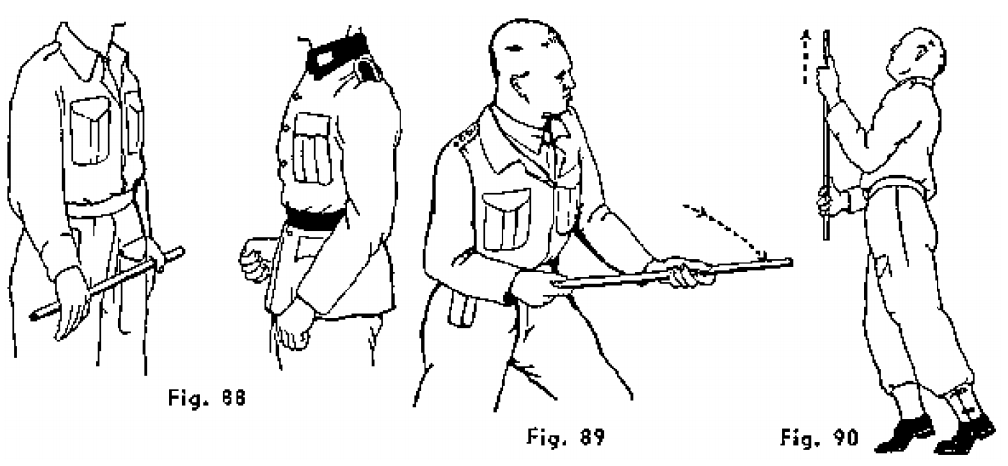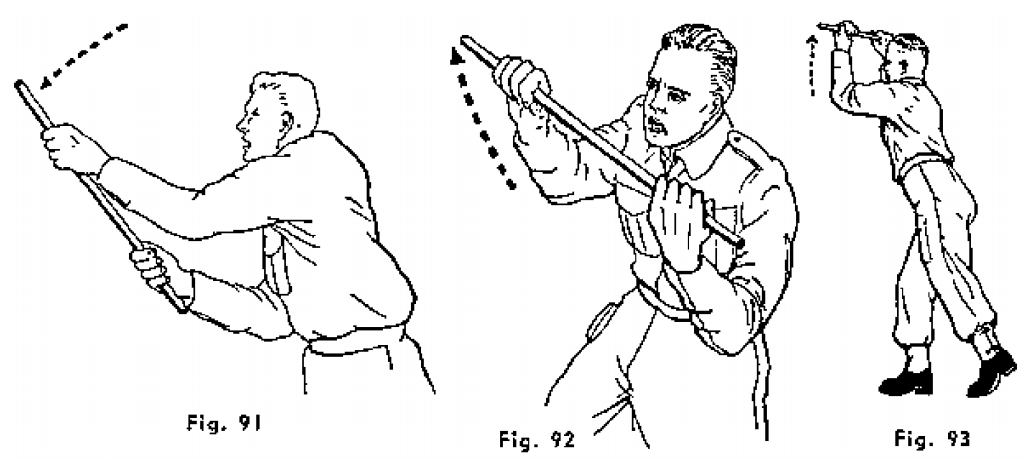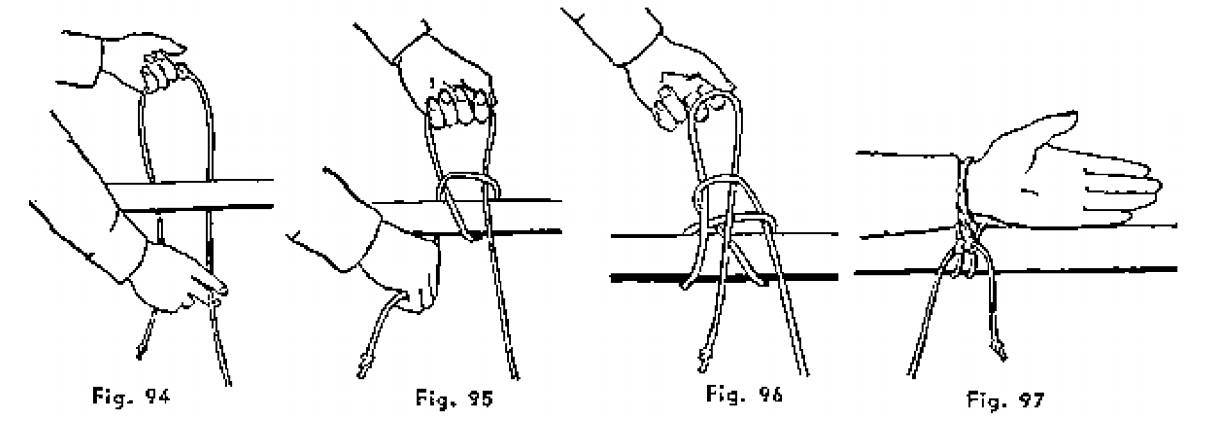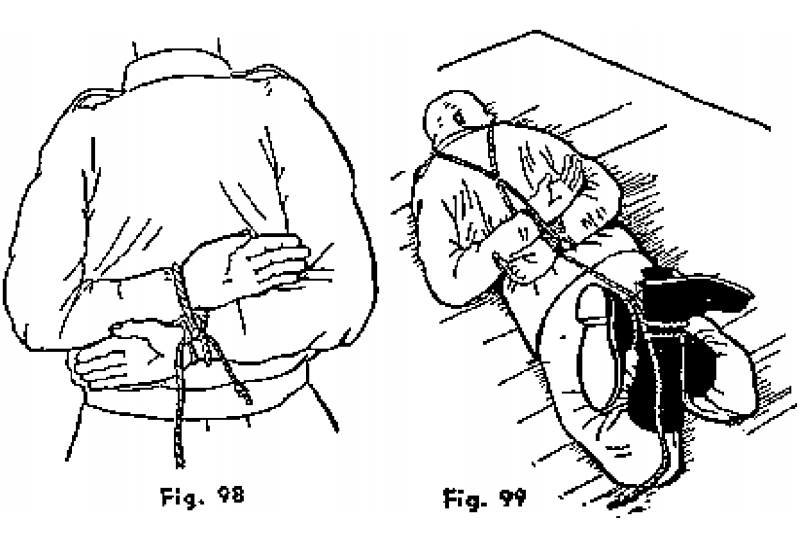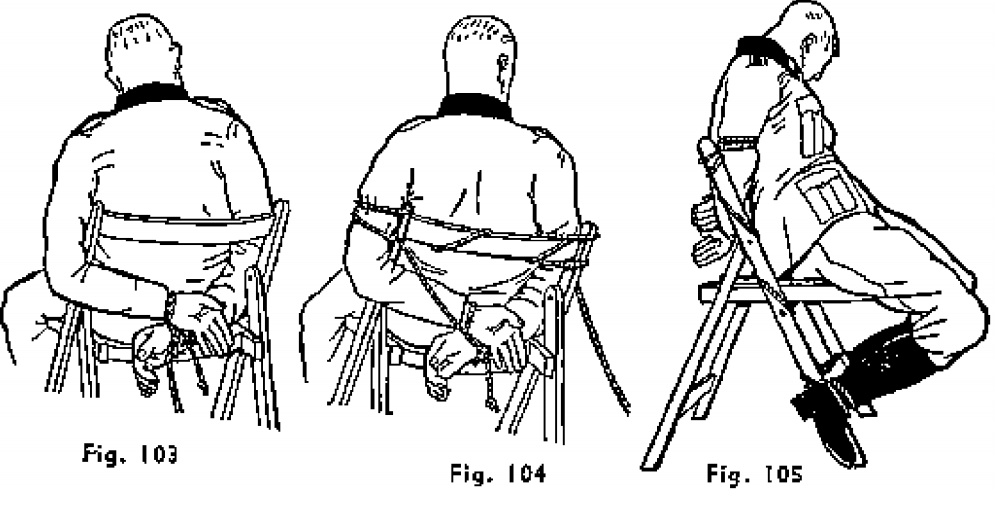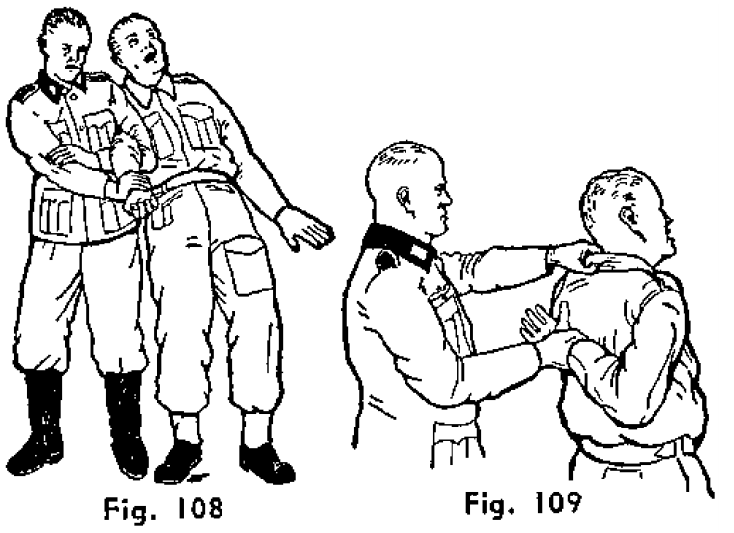GET TOUGH !
MAJOR W.E. Fairbairn 1943
MISCELLANEOUS ADVICE
NO. 21 - CHAIR AND KNIFE
Most lion tamers consider a small chair to be sufficient to keep a lion from attacking them. Should you be so fortunate as to have a chair handy when your opponent is attacking you with a knife, seize the chair as in Fig. 72. Rush at him, jabbing one or more of the legs of the chair into his body. The odds in favor of your overpowering your opponent are roughly three to one, and well worth taking (Fig. 73).
Most lion tamers consider a small chair to be sufficient to keep a lion from attacking them. Should you be so fortunate as to have a chair handy when your opponent is attacking you with a knife, seize the chair as in Fig. 72. Rush at him, jabbing one or more of the legs of the chair into his body. The odds in favor of your overpowering your opponent are roughly three to one, and well worth taking (Fig. 73).
NO. 22-THE MATCH-BOX ATTACK
You are sitting down, say, in a railway coach. Your opponent, who is on your left, sticks a gun in your ribs, holding it in his right hand.
1. Take a match-box and hold it as in Fig. 74, the top of the box being slightly below the finger and thumb.
2. Keeping the upper part of the right arm close to the right side of your body, with a circular upward motion of your right fist, turning your body from the hip, strike your opponent hard on the left side of his face, as near to the jawbone as possible (Fig. 75); parry the gun away from your body with your left forearm.
You are sitting down, say, in a railway coach. Your opponent, who is on your left, sticks a gun in your ribs, holding it in his right hand.
1. Take a match-box and hold it as in Fig. 74, the top of the box being slightly below the finger and thumb.
2. Keeping the upper part of the right arm close to the right side of your body, with a circular upward motion of your right fist, turning your body from the hip, strike your opponent hard on the left side of his face, as near to the jawbone as possible (Fig. 75); parry the gun away from your body with your left forearm.
|
Note. - The odds of knocking your opponent unconscious by this method are at least two to one. The fact that this can be accomplished with a match-box is not well-known, and for this reason is not likely to raise your opponent's suspicion of your movements. Naturally, all movements, from the start of the blow, must be carried out with the utmost speed.
|
NO. 23 - SMACKING THE EARS
This method should be applied when your opponent has no protection over his ears.
1. Cup your hands, keeping the fingers and thumbs bent and close together, as in Fig. 76.
2. Strike your opponent simultaneously over both ears, using five to ten pounds force (Fig. 77).
This method should be applied when your opponent has no protection over his ears.
1. Cup your hands, keeping the fingers and thumbs bent and close together, as in Fig. 76.
2. Strike your opponent simultaneously over both ears, using five to ten pounds force (Fig. 77).
Note. - This will probably burst one or both ear-drums, give him at least a mild form of concussion, and make him what is known in boxing circles as "punch-drunk." You will then have no difficulty in dealing with him in any way you wish. So that you may realize what the effect of a blow given as above is like, apply it on yourself, as in Fig. 77A. Care must be taken to use only half a pound force with each hand.
NO. 24 – THE ART OF GETTING UP FROM THE GROUND
|
You will have noted that no holds or locks on the ground are demonstrated. The reason for this is:
(a) THIS IS WAR: your object is to kill or dispose of your opponent as quickly as possible and go to the assistance of your comrades. (b) Once on the ground, you are more vulnerable to attack. (See No. 3B, Bronco Kick.) (c) It takes months of constant daily practice to master the an of falling, and personal instruction from a qualified instructor is essential. (d) There is a vast difference between falling on mats in a gymnasium and falling on a road or rocky ground. |
Even a roll on to a stone or a small stump of a tree, should it press into the kidneys, would certainly put you out of the fight permanently. It is, therefore, obvious that you should concentrate on remaining on your feet.
No attempt is made to teach you how to fall, but the following guides are given on how to get back on your feet if you do fall or are thrown:
1. You are on the ground, as in Fig. 78.
2. Turn your body sharply towards your left-hand side, stomach to the ground, rising by the help of the right forearm and right knee to the position shown in Fig. 79.
3. Pushing on the ground with both hands, force yourself backwards into the position shown in Fig. 80, and then stand up.
Note. - All the above movements muse be one rapid and continuous roll or twist of the body.
If, when in the position shown in Fig. 80, your opponent is behind you, place your right foot as near as possible to your left hand (Fig. 81), turn sharply on both feet towards your lefthand side, and you will find yourself facing your opponent.
No attempt is made to teach you how to fall, but the following guides are given on how to get back on your feet if you do fall or are thrown:
1. You are on the ground, as in Fig. 78.
2. Turn your body sharply towards your left-hand side, stomach to the ground, rising by the help of the right forearm and right knee to the position shown in Fig. 79.
3. Pushing on the ground with both hands, force yourself backwards into the position shown in Fig. 80, and then stand up.
Note. - All the above movements muse be one rapid and continuous roll or twist of the body.
If, when in the position shown in Fig. 80, your opponent is behind you, place your right foot as near as possible to your left hand (Fig. 81), turn sharply on both feet towards your lefthand side, and you will find yourself facing your opponent.
NO. 24A - GETTING UP FROM THE GROUND (BACKWARDS)
|
1. You have fallen on to your back on the ground.
2. Lie flat on your back and place your right arm at an angle of 90 degrees from the body, the back of your hand on the ground and your head turned towards your left shoulder (Fig. 82). 3. Raise your legs from the waist and shoot them over your right shoulder (Fig. 83). When in this position, allow your right arm and hand to turn with your body. |
4. Bend your right leg and bring it to the ground as close to your right arm as possible. Keeping your left leg straight reach as far back with it as possible (Fig. 84).
5. Your left hand will be on the ground approximately opposite your right knee. Press on the ground with both hands and force yourself up on to your right knee. Continue the pressure until you are on your feet (Fig. 85).
Note. - The reason for keeping your feet apart in the movement shown in 4 is that you will immediately be on-balance when you come up on your feet. This is a very important point to note and is very seldom taken care of by the average man. A man off-balance can be pushed down again with a few pounds' pressure of either hand. Moreover, he cannot administer an effective blow or even defend himself properly.
5. Your left hand will be on the ground approximately opposite your right knee. Press on the ground with both hands and force yourself up on to your right knee. Continue the pressure until you are on your feet (Fig. 85).
Note. - The reason for keeping your feet apart in the movement shown in 4 is that you will immediately be on-balance when you come up on your feet. This is a very important point to note and is very seldom taken care of by the average man. A man off-balance can be pushed down again with a few pounds' pressure of either hand. Moreover, he cannot administer an effective blow or even defend himself properly.
NO. 25 - ATTACK WITH A SMALL STICK OR CANE
A man without a weapon to defend himself, especially after long exposure, is very likely to give up in despair. It is remarkable what a difference it would make in his morale if he had a small stick or cane in his hand.
Now, add to this the knowledge that he could, with ease, kill any opponent with a stick, and you will then see how easy it is to cultivate the offensive spirit which is so essential in present-day warfare.
A man without a weapon to defend himself, especially after long exposure, is very likely to give up in despair. It is remarkable what a difference it would make in his morale if he had a small stick or cane in his hand.
Now, add to this the knowledge that he could, with ease, kill any opponent with a stick, and you will then see how easy it is to cultivate the offensive spirit which is so essential in present-day warfare.
|
1. A small stick of 18 to 24 inches in length and about i inch in thickness will make an ideal weapon. (If one is not available, it can be broken off a tree.)
Note. - If you are to be successful in the application of this method, it is essential for you to have the element of surprise on your side. This can best be obtained by taking the position shown in Fig. 86. |
2. Retaining your hold of the stick with your right hand, 'swing the other end up and catch it in your left hand about six inches from the end. This should be done without looking down at your hands or stick. Pay particular attention to the position of the hands (Fig. 87).
Note. - The reason for using this unusual hold of the stick should be obvious. It is not at all likely that anyone (not previously aware of this particular method of attack) would have the slightest suspicion that he was in danger of being attacked.
Note. - The reason for using this unusual hold of the stick should be obvious. It is not at all likely that anyone (not previously aware of this particular method of attack) would have the slightest suspicion that he was in danger of being attacked.
NO. 25 - ATTACK WITH A SMALL STICK OR CANE (cont)
You are close up and facing your opponent, as in Fig. 88.
1. Strike your opponent across the stomach with the left end of the stick by a vicious circular motion towards your right-hand side. In delivering this blow, there are four essential points that must be carried out simultaneously:
You are close up and facing your opponent, as in Fig. 88.
1. Strike your opponent across the stomach with the left end of the stick by a vicious circular motion towards your right-hand side. In delivering this blow, there are four essential points that must be carried out simultaneously:
|
(c) The movement of your right hand is inwards to the left, but much shorter than that of the left hand, because of your right hand's coming against your right side.
|
(d) The movement of your left foot is forward towards the right. This permits you to put the weight of your body behind the blow. See Fig. 89.
|
NOTE. - This blow across your opponent's stomach would not, if he were wearing thick clothing, put him out, but it would surely make him bring his chin forward, which is exactly the position you want him in.
2. Keeping the firmest possible grip of the stick with both hands, jab upwards with the end of the stick (left-hand end) and drive it into his neck and kill him (Fig. 90). The mark you are after is the soft spot about two inches back from the point of the chin. You have missed your opponent's chin when you attacked as in Fig. 90.
3. Smash him down the face with the end of the stick, as in Fig. 91, putting all the weight of your body behind the blow.
4. If necessary, follow-up with a smash across the left side of your opponent's face with the right-hand end of the stick, as in Fig. 92.
Note. - You have taken a step to your left front with your right foot to permit of the weight of the body being behind the blow.
2. Keeping the firmest possible grip of the stick with both hands, jab upwards with the end of the stick (left-hand end) and drive it into his neck and kill him (Fig. 90). The mark you are after is the soft spot about two inches back from the point of the chin. You have missed your opponent's chin when you attacked as in Fig. 90.
3. Smash him down the face with the end of the stick, as in Fig. 91, putting all the weight of your body behind the blow.
4. If necessary, follow-up with a smash across the left side of your opponent's face with the right-hand end of the stick, as in Fig. 92.
Note. - You have taken a step to your left front with your right foot to permit of the weight of the body being behind the blow.
|
5. If at any time after the initial attack across the stomach your opponent's head is high in the air, exposing the front part of his neck: Aim to strike the "Adam's apple" with the center of the stick, putting every ounce of strength behind the blow. This should kill him, or at least knock him unconscious (Fig. 93).
|
Note. - Methods No. 2 (the point, up under the chin) and No. 5 (the center, into the "Adam's apple") are finishing-off or killing blows, but you must first bring your opponent into the position that permits you to deal them effectively. Method No. i (the point across the stomach) will, on account of its unexpectedness, enable you to accomplish this, and your attack should always start with the stomach attack.
NO. 26 - VARIOUS METHODS OF SECURING A PRISONER
All raiding parties should have among their equipment a small roll of adhesive tape, preferably of one or more inches in width, and a length of silk rope or cord, about a quarter of an inch in diameter and about five yards in length, for gagging and securing a prisoner whom they wish to leave unguarded.
To Gag a Prisoner.- Force a piece of cloth or a lump of turf into his mouth; then place two or more strips of adhesive tape, approximately four and a half inches in length, firmly over his mouth, taking care not to cover his nostrils.
Tying the Highwayman's Hitch.--This knot should be practiced on a pole or the back of a chair, until it can be done in the dark.
All raiding parties should have among their equipment a small roll of adhesive tape, preferably of one or more inches in width, and a length of silk rope or cord, about a quarter of an inch in diameter and about five yards in length, for gagging and securing a prisoner whom they wish to leave unguarded.
To Gag a Prisoner.- Force a piece of cloth or a lump of turf into his mouth; then place two or more strips of adhesive tape, approximately four and a half inches in length, firmly over his mouth, taking care not to cover his nostrils.
Tying the Highwayman's Hitch.--This knot should be practiced on a pole or the back of a chair, until it can be done in the dark.
1. Holding the cord with a short end (about two feet), pass it behind the pole, with the short end to the left and the long to the right (Fig. 94).
2. Pass the long end, in a loop, up and over the pole and through the loop held in the left hand. Then pull down on the short end with the right hand (Fig. 95).
3. Pass the short end of the cord, in a loop, up and over the pole and through the loop held in the left hand, and form the knot shown in Fig. 96.
4. Holding the loop in the left hand, pull down on the long end of the cord, pass the left hand through the loop and then pull on both ends of the cord and tie two half-hitches to prevent slipping (Fig. 97).
2. Pass the long end, in a loop, up and over the pole and through the loop held in the left hand. Then pull down on the short end with the right hand (Fig. 95).
3. Pass the short end of the cord, in a loop, up and over the pole and through the loop held in the left hand, and form the knot shown in Fig. 96.
4. Holding the loop in the left hand, pull down on the long end of the cord, pass the left hand through the loop and then pull on both ends of the cord and tie two half-hitches to prevent slipping (Fig. 97).
NO. 26 - VARIOUS METHODS OF SECURING A PRISONER (cont.)
A - From the Handcuff Hold
A - From the Handcuff Hold
|
1. Throw your prisoner to the ground on his stomach, tying his wrists together behind his back by means of the Highway man's Hitch, as in Fig. 98, and force his arms well up his back.
2. Pass the cord around his neck; then back and around his wrists again; then bend his legs backwards and tie his legs together, as in Fig. 99. |
Note. - If your prisoner keeps still, he will not hurt himself, but should he attempt to struggle, he will most likely strangle himself.
|
NO. 26 - VARIOUS METHODS OF SECURING A PRISONER (cont.)
B -"The Grape Vine" Select a tree, post, or lamp-post of about seven inches in diameter. 1. Make your prisoner climb on the tree as in Fig. 100. 2. Place his right leg around the front of the tree, with his foot to the left. Place his left leg over his right ankle, as in Fig. 101, and take his left foot back behind the tree. |
3. Force him well down the pole until the weight of his body locks his left foot around the tree, as in Fig. 102.
Note. - Even though you have left your prisoner's hands free, it will, if he has been forced well down the tree, be almost impossible for him to escape. Normally, the average man placed in this position would get cramp in one or both legs within ten to fifteen minutes, when it is not at all unlikely that he would throw himself backwards. This would kill him.
Caution. - To release your prisoner: Two persons are necessary, one on either side. Take hold of his legs and lift him up the tree; then unlock his legs.
Note. - Even though you have left your prisoner's hands free, it will, if he has been forced well down the tree, be almost impossible for him to escape. Normally, the average man placed in this position would get cramp in one or both legs within ten to fifteen minutes, when it is not at all unlikely that he would throw himself backwards. This would kill him.
Caution. - To release your prisoner: Two persons are necessary, one on either side. Take hold of his legs and lift him up the tree; then unlock his legs.
NO. 26. - VARIOUS METHODS OF SECURING A PRISONER (cont.)
2. Tie the upper part of his arms to the chair, one on either side (Fig. 104).
3. Tie both feet to the chair - one on either side - with only the toes of his boots resting on the ground, as in Fig. 105. 4. Gag him, if necessary.
3. Tie both feet to the chair - one on either side - with only the toes of his boots resting on the ground, as in Fig. 105. 4. Gag him, if necessary.
NO. 26 - VARIOUS METHODS OF SECURING A PRISONER (cont.)
D - A Substitute for Handcuffs
The following method, whereby one man can effectively control two to six prisoners, may be found very useful. A police baton, night stick, or hunting crop, preferably fitted with a cord thong, as in Fig. 106, is all that is required.
1. Cut your prisoners' trouser-belts and/or suspenders, then thoroughly search them for concealed weapons.
2. Make them all put their right wrists through the loop of the thong, and twist the baton until the thong cuts well into their wrists (Fig. 107). Then march them off.
D - A Substitute for Handcuffs
The following method, whereby one man can effectively control two to six prisoners, may be found very useful. A police baton, night stick, or hunting crop, preferably fitted with a cord thong, as in Fig. 106, is all that is required.
1. Cut your prisoners' trouser-belts and/or suspenders, then thoroughly search them for concealed weapons.
2. Make them all put their right wrists through the loop of the thong, and twist the baton until the thong cuts well into their wrists (Fig. 107). Then march them off.
NO. 27 - BREAKAWAYS FROM "COME-ALONG" GRIPS
|
A number of so called "come-along" grips are frequently demonstrated and taught as being 100 per cent perfect, and impossible, once secured, for any man to escape. Under certain circumstances it would, indeed, be difficult and painful to escape them; also it might result in a badly strained ligament. Nevertheless, any man of average build and strength can, with at least a 50 per cent chance of success, not only break away from these holds, but he will also be in a position from which he can with ease break his opponent's limbs and, if necessary, kill him.
|
Two fairly well-known holds that are so regarded are shown below: Fig. 108 - Police Come-Along Grip, and Fig. 109 - Collar and Wrist Hold.
You must face the fact that a man fighting for his life or to prevent capture is a vastly different person from one you may meet in competition. It is an established fact that a man in fear of death will be prepared to undertake the lifting of five times the weight he would in normal times, also that he can, under such circumstances, take about five times the usual amount of punishment.
Tills is not said with the idea of preparing you to take a lot of punishment should you attempt to break either of these holds, but simply to show you that even if you fail, you will not be in a much worse position than you were originally. The question will be asked: "Why is it that these holds have been so commonly accepted as being unbreakable?"
The answer is: Those of us who have made a study of the art of attack and defense well know that the average student is too inclined to demonstrate his prowess on his friends after only a few lessons, and before he has mastered even the initial movements. This often results in broken bones, etc. Further, the counter-measures used to break holds such as these are drastic in the extreme, and are shown to students only after they have proved beyond doubt that they would not willfully misapply them.
Tills is not said with the idea of preparing you to take a lot of punishment should you attempt to break either of these holds, but simply to show you that even if you fail, you will not be in a much worse position than you were originally. The question will be asked: "Why is it that these holds have been so commonly accepted as being unbreakable?"
The answer is: Those of us who have made a study of the art of attack and defense well know that the average student is too inclined to demonstrate his prowess on his friends after only a few lessons, and before he has mastered even the initial movements. This often results in broken bones, etc. Further, the counter-measures used to break holds such as these are drastic in the extreme, and are shown to students only after they have proved beyond doubt that they would not willfully misapply them.
1. Exaggerate the pain you are receiving by shouting or groaning. Try to be out of step with him, which makes it easier to apply your counter. Only resist sufficiently to prevent him from being suspicious.
2. Do not be in a hurry to apply your counter. The opening will be there every time he puts the weight of his body on his left foot.
3. Smartly jab the outside of your right leg against the outside of his left leg, forcing his leg inwards, and break it (Fig. 110), simultaneously pulling your right arm towards you, which, in addition to increasing the force of your leg blow, also permits you to bend your arm and break his hold. If necessary, apply the edge-of-the-hand blow on the back of his neck with your left hand, and kill him.
B - Your Opponent Has Hold of You as in Fig. 109
1. As in the previous method, wait until your opponent is off his guard and only resist slightly.
2. Turn sharply around towards your left-hand side, simultaneously bending your legs at the knees and your head forward to permit your head to go under his left arm. Then straighten up your head. (These movements, in addition to twisting his arm, will lock his left hand in the back of your collar.) Strike the elbow of his left arm a vicious upward jab with the palm of your right hand, as in Fig. in. If necessary, follow up with a chin jab with your left hand, or knee to the testicles with either knee.
2. Do not be in a hurry to apply your counter. The opening will be there every time he puts the weight of his body on his left foot.
3. Smartly jab the outside of your right leg against the outside of his left leg, forcing his leg inwards, and break it (Fig. 110), simultaneously pulling your right arm towards you, which, in addition to increasing the force of your leg blow, also permits you to bend your arm and break his hold. If necessary, apply the edge-of-the-hand blow on the back of his neck with your left hand, and kill him.
B - Your Opponent Has Hold of You as in Fig. 109
1. As in the previous method, wait until your opponent is off his guard and only resist slightly.
2. Turn sharply around towards your left-hand side, simultaneously bending your legs at the knees and your head forward to permit your head to go under his left arm. Then straighten up your head. (These movements, in addition to twisting his arm, will lock his left hand in the back of your collar.) Strike the elbow of his left arm a vicious upward jab with the palm of your right hand, as in Fig. in. If necessary, follow up with a chin jab with your left hand, or knee to the testicles with either knee.

